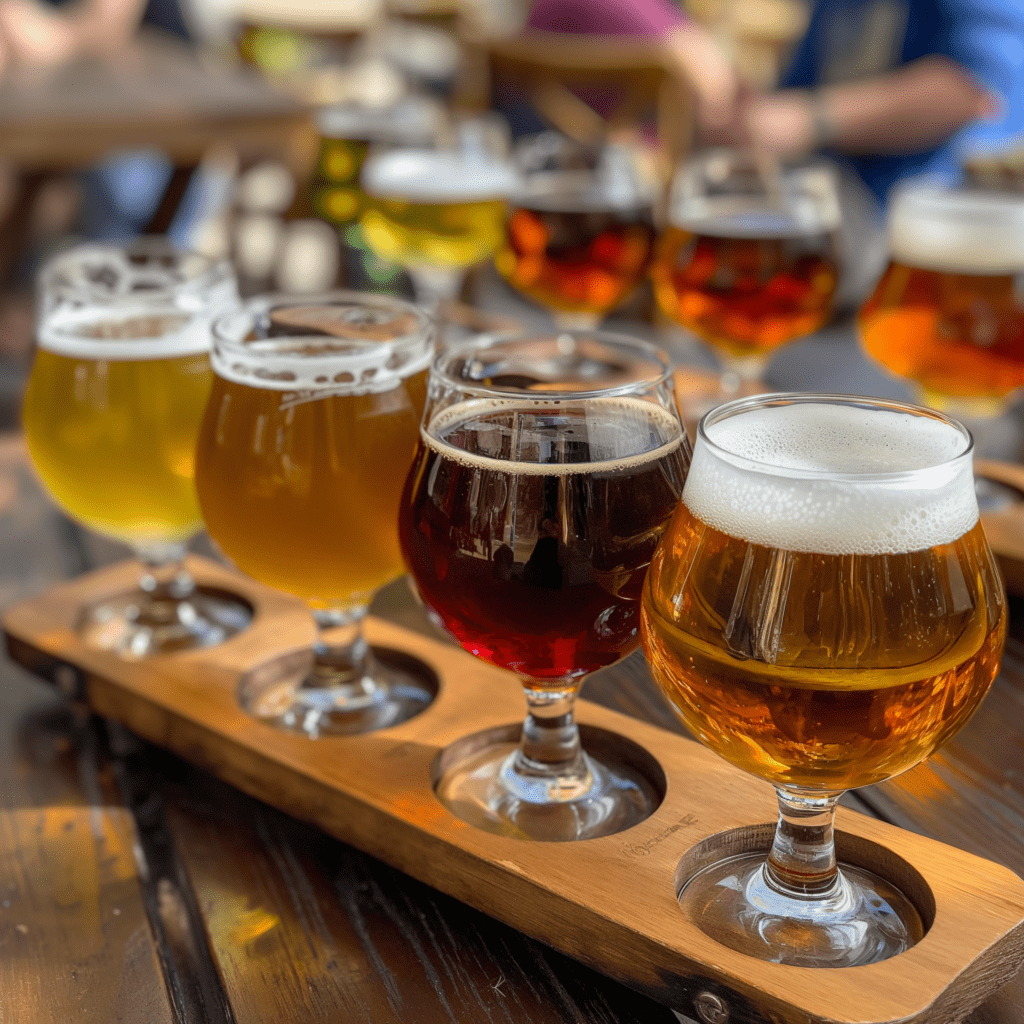Ever sipped on a refreshing pale ale or enjoyed the bold flavors of an IPA? These distinct craft beer styles have captured the hearts (and palates) of beer enthusiasts worldwide. But do you know the fascinating stories behind these brews and the difference between pale ale and IPA in terms of flavor, mouthfeel, and history? Join us as we explore the origins and nuances of pale ales and IPAs, and discover how to choose the perfect brew for your taste buds.
Key Takeaways
Pale ales and IPAs are both hop-forward beers with distinct differences in intensity, bitterness, mouthfeel, ABV and flavor profile.
Explore the many variations of pale ale & IPA styles to uncover unique flavors & characteristics.
Pair your chosen brew with food or discover local breweries for delicious options!
Understanding Pale Ale

Tracing their origins back to the 1600s in the UK, pale ales have an intriguing history. They were born out of a desire for a lighter, more refreshing beer, thanks to the use of coke-dried pale malts, which gave the brew a lighter colour and the nickname “hazy pale”. Today, the hazy pale ale continues to be a popular choice for those seeking a refreshing and flavorful beer experience.
The crisp taste, hop-forward flavor, and refreshing bitterness of pale ales have earned them widespread popularity.
British Origins
In the UK, the birthplace of the pale ale, beers were traditionally brewed with darker malts, resulting in darker, more robust ales. The introduction of coke-dried malts revolutionized the brewing process, paving the way for the creation of a lighter, more golden beer style – the pale ale. Often referred to as “bitters,” these beers enjoyed rapid popularity due to their balanced flavors and easy drinkability. British breweries played a significant role in this transformation, adapting to the new techniques and contributing to the widespread appeal of the pale ale.
Modern bitters, a popular UK style, are categorized into “session,” “best,” and “strong” bitters based on their alcohol content, showcasing the diversity within this classic British beer style.
American Pale Ale Evolution
During the craft beer revolution of the late 70s and early 80s, American brewers started to reinterpret the traditional English pale ale recipes, adding their unique touch. Jack McAuliffe from the New Albion Brewing Company and Bert Grant from Yakima Brewing were pioneers in the field. They helped shape American pale ale into its distinct form. American pale ales use American hops, like Cascade, which impart intense citrus and pine notes, setting them apart from their English counterparts.
Boasting a cleaner yeast profile and an ABV around 5%, American pale ales have carved a niche for themselves in the craft beer world.
IPA: India Pale Ale Uncovered

India Pale Ales (IPAs) have captured the imagination of craft beer enthusiasts across the globe. Originally created in England for export to India, IPAs have evolved into a versatile and popular beer style, boasting a wide range of substyles, each with its own unique characteristics. With options ranging from the classic British IPA to the hoppy American version, you’re sure to find an IPA that suits your palate.
IPA’s Adventurous History
IPAs were born out of necessity during the 18th century when British brewers sought to create a beer that could withstand the long and arduous journey from England to India. By adding extra hops to the brewing process, these intrepid brewers discovered that the beer not only survived the trip but also developed a unique, bold flavor profile.
Modern brewers have taken IPAs far beyond their humble beginnings, experimenting with new hops and techniques to concoct a spectrum of captivating flavors and aromas in their beer brewed creations.
The Craft Beer Revolution
The rise of the craft beer industry has led to an explosion of creativity and innovation in the world of IPAs. Brewers have pushed the boundaries of the style, experimenting with new techniques and unique ingredients to create a diverse range of substyles, such as the fruit-forward New England IPA and the piney West Coast IPA.
The IPA category offers a world of flavors to explore, with hop profiles spanning from citrusy and tropical to resinous and earthy notes.
Comparing Pale Ale and IPA

Pale ales and IPAs may both be hop-forward beers, but they differ in several key aspects. While pale ales are known for their balanced flavor profile and lighter body, IPAs often showcase a more intense hop presence and higher bitterness.
A deeper exploration of these differences will reveal what sets each style apart.
Hops and Bitterness
IPAs are known for their strong hop presence, which results in a more bitter flavor compared to pale ales. The hop content in IPAs is generally higher, leading to a more noticeable hop aroma, flavor, and bitterness.
The bold and bitter character of IPAs stems from their brewing process, which typically involves using more hops for additional hop additions.
Flavour Profiles
In terms of flavor profiles, pale ales tend to be more balanced, with a noticeable malt backbone and moderate hop bitterness. IPAs, on the other hand, can range from fruity and tropical to piney and resinous, with a more pronounced hoppy flavor and higher alcohol content. The variety of hops used in each style can greatly impact the resulting flavors, with different hop strains bringing out unique citrus, pine, floral, earthy, and fruity notes.
Mouthfeel and ABV
Pale ales often have a fuller body compared to IPAs, which can have a drier mouthfeel and higher alcohol content. The difference in ABV between the two styles can also play a role in their mouthfeel, with IPAs typically having a higher ABV, resulting in a drier finish and lighter mouthfeel.
When it comes to choosing between a pale ale and an IPA, personal preference will ultimately guide your decision based on mouthfeel and desired alcohol content.
Variations Within Pale Ale and IPA Styles

Both pale ales and IPAs boast numerous substyles, offering beer enthusiasts a wealth of options to explore. Here are some of the most popular substyles within these two beer categories:
Amber ales
American pale ales
English pale ales
India pale ales (IPAs)
Double IPAs
New England IPAs
Black IPAs
Belgian IPAs
Delve into these substyles and discover the diverse flavors and characteristics they have to offer.
Pale Ale Substyles
Popular pale ale substyles include:
Amber ale: characterized by their rich, amber color and often feature pine notes in their flavor profile, thanks to the use of American-variety hops.
Blonde ale: a light, refreshing beer with a pale golden color and a slightly sweet, malty flavor.
English bitter: a traditional British beer with a balanced hop bitterness and a malty backbone.
Blonde ales, on the other hand, are known for their light, easy-drinking quality, and typically showcase more malt, hops, yeast, and water as their main components.
English bitters stand out for their balanced hop flavor and bitterness, achieved through a unique brewing process that incorporates a single bittering charge and moderate flavor and aroma dose.
IPA Substyles

IPA substyles are as diverse as the beer enthusiasts who enjoy them. West Coast IPAs showcase strong, hoppy flavors with intense citrus and pine aromas, complemented by a clean and dry finish.
New England Style IPAs, like those brewed by northern monk, are known for their hazy appearance, low bitterness, and juicy, fruity flavor profiles.
Belgian IPAs, on the other hand, blend the characteristics of a British IPA with a Belgian tripel, incorporating spicy and fruity notes derived from Belgian yeast strains.
Choosing Your Perfect Brew: Pale Ale vs IPA

Now that you’re familiar with the differences between pale ales and IPAs, as well as their various substyles, you’re ready to select your ideal brew. Consider factors such as food pairings and local brewery offerings to help guide your decision.
Pairing with Food
When it comes to food pairings, both pale ales and IPAs can complement a wide range of dishes. Some food pairings for pale ales include:
Salads
Fish
Poultry
Milder cheeses like brie and goat cheese
IPAs, on the other hand, can stand up to bolder flavors, making them ideal partners for spicy foods, grilled meats, and strong cheeses like aged cheddar. The versatility of both pale ales and IPAs means you’re sure to find a brew that enhances your dining experience.
Exploring Local Breweries
Exploring local breweries provides a great opportunity to discover your perfect pale ale or IPA. Here are some tips to make the most of your brewery visits:
Sample different styles and substyles.
Don’t be afraid to ask the brewery staff for their recommendations or more information about the beers on offer.
As you taste various brews, take note of the appearance, aroma, and flavor.
Consider your personal preferences and what you enjoy in a beer.
By following these tips, you can have a fun and educational experience while exploring local breweries.
With so many incredible pale ales, other beers, and IPAs to choose from, you’re bound to find a brew that captivates your taste buds and keeps you coming back for more.
Summary
In the exhilarating world of craft beer, pale ales and IPAs offer a diverse landscape of flavors, styles, and histories. From their British origins to the creative adaptations of modern brewers, these beloved beer styles continue to delight drinkers with their unique characteristics. Whether you prefer the balanced flavors of a pale ale or the bold intensity of an IPA, there’s a perfect brew out there just waiting to be discovered. So, raise a glass and toast to the endless possibilities of pale ales and IPAs!
Frequently Asked Questions
Is pale ale the same as IPA?
IPA is a style of pale ale beer that has more hops added to give it a stronger flavour and higher alcohol by volume (ABV) compared to regular pale ales. IPAs also have bigger hop aromas and flavours, as well as higher International Bittering Units (IBU) than their pale ale cousins. So while IPAs are derived from pale ales, they still have distinct differences.
Is pale ale stronger than IPA?
Based on the alcohol content, IPAs are generally stronger than pale ales, with an ABV range of 5-7.5% compared to 4.5-5.8%. Double IPAs have an even higher ABV range of 7.5-9.5%.
Why is IPA called pale ale?
IPA stands for India Pale Ale and was originally developed by British brewers to survive the long voyage from Britain to India during colonial times. It had a higher hop content than traditional pale ale, which helped to preserve it on the journey. This is why IPA is called pale ale.
What is the difference between a beer ale and a IPA?
IPA is a strong, hoppy style of beer that is more intense than regular pale ales. It has a stronger aroma and flavor, higher alcohol content, and a higher IBU (International Bitterness Unit).
How do British and American pale ales differ?
British pale ales are maltier and have a balanced hop character, while American pale ales feature intense hop flavors like citrus and pine.

Leave a Reply